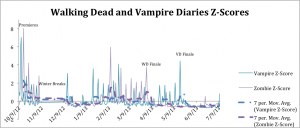24 Weeks Later: Zombies Live
Our last post looked at the two populations of Walking Dead and Vampire Diaries watchers as separate populations. The next challenge was to uniformly compare two audience groups and their social media activity on Twitter. Argus obtained buzz data for The Vampire Diaries and The Walking Dead by seeking Tweets with the words ‘vampire diaries’ or ‘walking dead’ in their body. Hence, there is a sample bias and it explains why Argus had more data for The Vampire Diaries than for The Walking Dead; while Tweets with the word ‘vampire’ were evaluated, Tweets with the word ‘zombie’ were not. Due to this disparity, it was necessary for Argus to equally compare the two groups to accurately assess buzz and viewership. The statistical tool used to enable this comparison was computing the Z-score for the two populations.
Z-scores were essential to analyzing the social dynamics of these populations. Shifts in data, due to premieres and finales, in both shows were now compared on a uniform platform without the sample bias distorting outcomes. By disregarding the sample bias, Z-scores allowed Argus to compare analysis, unlike before. A standard score, or a Z-score, specifies how many standard deviations data or an observation are below or above the mean. A positive Z-score denotes a value above the mean while a negative Z-score indicates a value below the mean. This dimension-less measurement allowed Argus to further compare episodes of The Walking Dead and The Vampire Diaries based on social media buzz. After calculating the mean and standard deviation of buzz for both series, every episode was assigned a Z-score ranging from -1 to upwards of 8, meaning the buzz for that day was, at its peak, 8 times the standard deviation above the average. This allowed Argus insights to compare the relative viewership based on the disparate samples in a meaningful way. Figure 1 is a graphical representation of the scores.

Season premieres saw the highest Z-score of any episodes. The Vampire Diaries premiere had a Z-score of 7.03 while The Walking Dead premiere had a score of 8.05, meaning that the Walking Dead premiere was more popular than the Vampire Diaries broadcasting. The mid-season and finale broadcastings also attracted higher levels of viewers given the particular theatrics associated with the episode. Interestingly enough, The Vampire Diaries finale was more popular than The Walking Dead finale, a curious fact given that Walking Dead was more popular per broadcasting for all episodes. Once the finale aired there was less viewer buzz due to the lack of new, weekly content. However, Walking Dead buzz decreased as a slower rate after its finale than Vampire Diaries, which decreased at a significantly higher rate. This could be attributed to various things, for example the level of engagement with post-season content that either series offered viewers once the season had concluded. Nevertheless, whether or not grand finales drive future levels of viewership will be of interest in the coming seasons to Argus.
Based on the research of Lindsay Nichols and Griselda Arzate


Rob Schneider
August 5, 2013 @ 1:36 pm
I don’t understand any of this. But goddamn it do I like it.